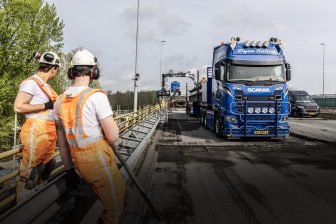Better transport links with EU Neighbours needed
Brussels, Belgium – The High Level Group set up by the European Commission last year to look at transport connections between the newly enlarged European Union and its 26 neighbours submitted its final report 7 december 2005. Recommendations include a mix of infrastructure projects and simpler measures aiming to stimulate trade and to facilitate traffic flows between countries along five major transnational transport axes. “Better integration of national networks will foster regional cooperation and integration not only between the EU and its neighbours but also between the neighbouring countries themselves. I am delighted with the speed and efficiency of the work of this Group. It is particularly appropriate given the 10th Anniversary of the Barcelona process and the ministerial meeting taking place in Marrakech on 16 December 2005†declared Vice-President Jacques Barrot, in charge of transport.
Chaired by former Transport Commissioner Ms Loyola de Palacio, the High Level Group comprised 53 countries[1] and 3 international financing institutions[2]. After a year of intensive work, the Group agreed on a set of priority measures, focussing efforts on 5 major transnational axes connecting the EU with the neighbouring countries in the North, East and South-East as well as around the Mediterranean and Black Sea regions.
The Group highlights its main priorities in the operational conclusions which include a number of infrastructure projects and several “soft†measures with the aim of removing physical and administrative bottlenecks along the main transport axes identified and to facilitate cooperation and communication between authorities in the different countries (harmonisation of documents and procedures, joint border control stations, etc). These measures include maritime safety and environmental protection, rail interoperability, extension of the European satellite radio navigation system (GALILEO) as well as the extension of the Single European Sky initiative to the neighbouring countries. The Group also wants to promote the exchange of best practice to explore the role of public-private partnerships in accelerating the implementation of the projects. Total cost of the projects is estimated at € 45 billion, of which € 35 billion should be found between 7december 2005 and 2020 primarily from the national budgets of the countries concerned and international financing institutions complemented by EU support.
The Group recommends that the Commission, the EU Member states as well as the Banks focus their cooperation and financing actions on the priority axes and on the horizontal measures identified in the report. The Group’s recommendations should also be adequately reflected in the cooperation agreements and action plans under the European Neighbourhood Policy. In this context, the Group considers that the twinning of an EU Member state with a neighbouring country could be a very useful and effective tool for implementing the horizontal measures, particularly in the areas of maritime and road safety as well as simplifying border crossing procedures. To ensure coherence of networks, implementation of the proposed measures should be synchronised along the axes.
The Chairman of the Group, Ms de Palacio and Vice-President Jacques Barrot will present the results of the Group’s work in Marrakech on 15-16 December 2005 where transport Ministers of the Mediterranean region will discuss transport priorities.
Based on the Group’s recommendations, Vice President Barrot intends next Spring to present a Communication to the Council and European Parliament on the way ahead.
The Group makes the following recommendations:
Support for a continuous process
– A review and update of the major axes/projects and of the horizontal measures in 2010 and regularly thereafter;
– A mid-term review in 2008 to prepare the update, based on information provided by the countries concerned.
Focussed and coordinated implementation of the axes
– To focus cooperation and financing actions on the five major axes and on the horizontal measures put forward by the Group.
– Exchange of best practice on financing options, including public-private partnerships, enabling legislation, user charging, etc. through regional workshops.
– To put in place strong and effective coordination frameworks, including sustainable long-term financial support, for the implementation of the proposed actions:
– Starting with a Memorandum of Understanding (MoU) for axes/regions where no such cooperation mechanism exists at present;
– Strengthening of existing MoUs into a binding Treaty.
– To launch twinning actions of an EU Member state and a neighbouring country by 2008 at the latest in view of the implementation of relevant horizontal measures.
Implementation of horizontal measures
– Simplification and facilitation of border crossing procedures including:
– Implementation in full and without delay of the relevant international Conventions and agreements, especially:
– the International Convention on the harmonisation of frontier controls for goods, particularly as regards corresponding opening hours of frontier posts, joint control of goods and documents through the provision of shared facilities, medico-sanitary and veterinary inspections;
– the Kyoto Convention on simplification and harmonisation of customs procedures aiming at maximum use of automated systems through the use of pre-arrival information, risk management techniques (including risk assessment and selectivity of controls) and easy access to information on customs requirements, laws, rules and regulations;
– the Convention of the international transport of goods (the TIR carnets) for road vehicles.
– Adoption by all the countries concerned by 2008 at the latest of the five IMO FAL documents, already in use in the EU.
– Simplification of the language regime:
– To mutually recognise all trade and transport related documents in the language of the country concerned and in a mutually agreed language.
– In the longer term, harmonisation of these documents.
– Implementation of “one-stop office†and development of electronic data inter-exchange systems (EDI) especially for ports.
– Promotion of satellite radio navigation systems (Galileo).
– Introduction, application and control of security measures resulting from international agreements and standards as well as to carrying out of security audits.
– For the maritime transport and the Motorways of the Seas:
– Harmonisation of the practices and procedures of the Paris, Mediterranean and Black Sea MoUs at the highest level of performance. The European Commission is invited to approach the three MoUs in view of launching a dialogue for further cooperation.
– Ratification and implementation of the international standards and conventions (IMO) in a timely manner and in full, including e.g. the MARPOL convention related to single hull tankers, the AFS convention on antifouling systems.
– Technical support for actions to improve the quality of port infrastructure and services and to implement regular frequency of shipping services (at least once a week) operating on the Motorway of the Sea.
– As regards rail transport and interoperability
– To monitor the on-going efforts of the two legal systems (COTIF and OSJD) in view of a common consignment note.
– To undertake measures to render the transport laws more coherent and convergent.
– Gradual implementation of ERTMS[3] along the major axes, when relevant
– Standardised telematic applications for freight services.
– For inland waterways:
– To mutually open access for international traffic.
– To pursue the harmonisation of rules and safety standards,
– Implementation of traffic information systems that are mutually interoperable.
– Regarding road transport:
– To design and implement measures to improve road safety that address driver behaviour, vehicle safety, road infrastructure (safety audits) and traffic management systems,
– To gradually upgrade the road network along the major axes for vehicles of 11.5 ton axle load and of 4-metre height.
– For air transport:
– to gradually extend the principles of the Single European Sky initiative to the neighbouring regions along with the enlargement of the EU or on a voluntary basis.
[1] Albania, Algeria, Armenia, Azerbaijan, Belarus, Bosnia & Herzegovina, Croatia, Egypt, former Yugoslav Republic of Macedonia, Georgia, Israel, Jordan, Lebanon, Libya (as observer), Morocco, Moldova, Norway, Palestinian Authority, Russia, Serbia & Montenegro, Kosovo (under UNMIK administration in accordance with the United Nations Security Council Resolution 1244), Switzerland, Syria, Tunisia, Turkey and Ukraine as well as the 25 EU Member states and Bulgaria and Romania
[2] European Investment Bank, European Bank for Reconstruction and Development, World Bank
[3] European Rail Traffic Management System
U las zojuist één van de gratis premium artikelen
Onbeperkt lezen? Profiteer nu van de introductieaanbieding voor € 10,- per maand.
Bent u al abonnee?




